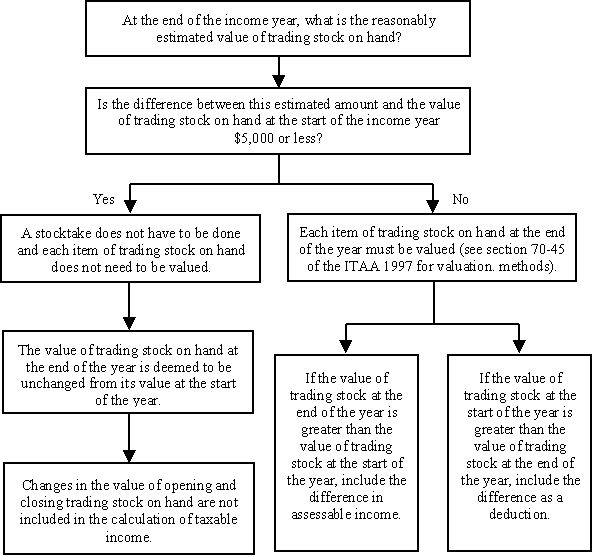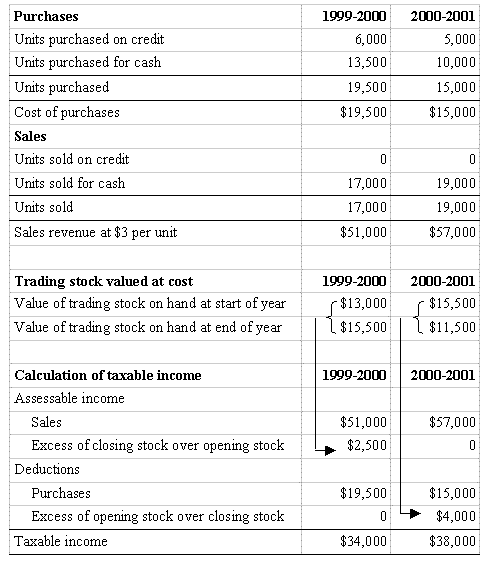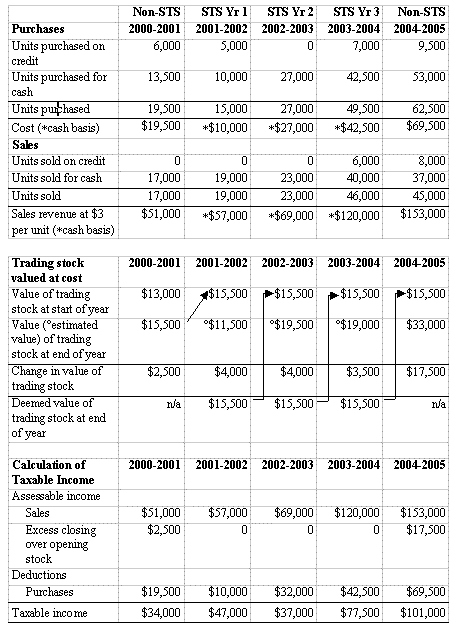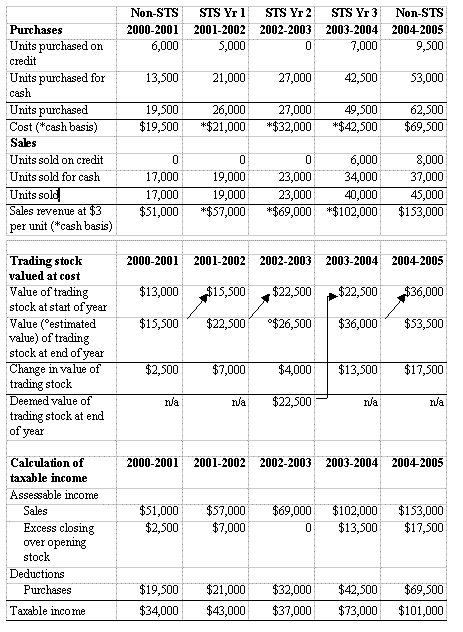Revised Explanatory Memorandum
(Circulated by authority of the Treasurer, the Hon Peter Costello, MP) THIS MEMORANDUM TAKES ACCOUNT OF AMENDMENTS MADE BY THE HOUSE OF REPRESENTATIVES TO THE BILL AS INTRODUCEDChapter 6 - Trading stock for taxpayers in the Simplified Tax System
Outline of chapter
6.1 This chapter sets out the method of accounting for trading stock while a taxpayer is in the STS. STS taxpayers will be subject to a modification of the existing trading stock rules contained in Division 70 of the ITAA 1997. In certain circumstances STS taxpayers will not have to account for changes in trading stock or do stocktakes at the end of the year.
Context of reform
6.2 Recommendation 170 of A Tax System Redesigned proposed that a simplified treatment of trading stock be implemented for certain small businesses. The existing law requires all business taxpayers with trading stock to conduct a stocktake at the end of each income year and to determine the value of each item of trading stock on hand for tax purposes. This value is compared with the value of trading stock on hand at the start of the year and the difference is included as either assessable income or a deduction. The proposed treatment for STS taxpayers is designed to reduce these compliance costs by requiring that changes in trading stock only be brought to account in certain limited circumstances.
6.3 Trading stock is defined in section 70-10 of the ITAA 1997 to include:
- •
- anything produced, manufactured or acquired that is held for purposes of manufacture, sale or exchange in the ordinary course of a business; and
- •
- live stock.
6.4 Division 70 of the ITAA 1997 contains the rules for the taxation treatment of trading stock. These provisions are designed to produce an overall result that reflects the activities of a taxpayer with trading stock during an income year. This is achieved by matching the cost of goods sold with sales revenue in the following way:
- •
- a deduction is allowed for expenditure incurred in acquiring trading stock under section 8-1 of the ITAA 1997 (Subdivision 70-B);
- •
- sales revenue is assessable under section 6-5 (Subdivision 70-D); and
- •
- an adjustment is made to either assessable income or deductions to take into account the change in value of trading stock on hand over the income year (Subdivision 70-C) if:
- -
- the value of trading stock on hand at the start of the income year is greater than the value at the end of the income year, a deduction is allowed for the excess; or
- -
- the value of trading stock on hand at the end of the income year is greater than the value at the start of the income year, an amount is included in assessable income equal to the excess.
6.5 This effectively gives a net deduction for trading stock equal to the cost of goods sold (i.e. opening stock plus purchases less closing stock) in each income year. This treatment is illustrated in Example 6.1.
Example 6.1: Treatment of trading stock under Division 70
At the start of the 1999-2000 year, Kramer has 13,000 units of trading stock on hand valued at a cost of $1 per unit ($13,000). During this year, he purchases another 19,500 units at $1 per unit and he sells 17,000 units at $3 per unit. From his stocktake at the end of the year, he determines that he has 15,500 units of trading stock on hand which he values at cost ($15,500).
Because the value of trading stock on hand at the end of the year ($15,500) is greater than the value at the start of the year ($13,000), the difference of $2,500 is included in assessable income.
At the start of the 2000-2001 year, Kramer has trading stock on hand valued at $15,500. During this year, he purchases another 15,000 units at $1 per unit and he sells 19,000 units at $3 per unit. From his stocktake, he determines that he has 11,500 units of trading stock on hand at the end of the year. Kramer again decides to value these units at cost ($11,500).
Because the value of trading stock on hand at the end of the year ($11,500) is less than the value at the start of the year ($15,500), the difference is allowed as a deduction of $4,000.
The following calculations illustrate the operation of Kramers trading stock account and the calculation of his taxable income over the 2 income years.
Summary of new law
6.6 Subdivision 328-E modifies the trading stock rules in Division 70 of the ITAA 1997 for STS taxpayers. The STS provides that:
- •
- where the difference between the value of trading stock on hand at the start of an income year and the reasonably estimated value at the end of the year is $5,000 or less, an STS taxpayer does
not
have to:
- -
- value each item of trading stock on hand at the end of the income year; or
- -
- account for any change in the value of trading stock on hand for income tax purposes; and
- •
- where the difference between the value of trading stock on hand at the start of the year and the reasonably estimated value at the end of the year is greater than $5,000, an STS taxpayer must:
- -
- value each item of trading stock on hand at the end of the year; and
- -
- account for the change in value of trading stock.
6.7 Diagram 60 provides an overview of how the trading stock rules will apply for STS taxpayers.
Diagram 6.1: STS trading stock overview

Comparison of key features of new law and current law
| New law | Current law |
|
Purchases of stock A deduction is allowed for the cost of acquiring trading stock in the year in which the payment is actually made. See Chapter 4 for an explanation of the accounting method for STS taxpayers. |
Purchases of stock A deduction is allowed, on an accruals basis, for expenditure incurred in acquiring trading stock. The deduction is allowed in the year in which the expense is incurred . |
|
Sales Sales revenue is included in assessable income in the year in which it is received . See Chapter 4 for an explanation of the accounting method for STS taxpayers. |
Sales Sales revenue is included in assessable income on an accruals basis, that is, in the year in which it is derived . |
|
Stocktakes The value of each item of trading stock on hand at the end of the income year does not need to be determined when the difference between the value of trading stock on hand at the start of the income year and the estimated value of trading stock on hand at the end of the year is $5,000 or less. |
Stocktakes Each item of trading stock on hand at the end of the income year must be valued at either cost, replacement price or market selling value. |
|
Accounting for changes in stock Variations in the value of trading stock must be taken into account in working out assessable income and deductions only when the difference between the value of trading stock on hand at the start of the income year and the estimated value of trading stock on hand at the end of the year is greater than $5,000. |
Accounting for changes in stock The difference between the value of trading stock on hand at the start and at the end of the income year must be brought to account under section 70-35 of the ITAA 1997. |
Detailed explanation of new law
Trading stock and the accounting method for STS taxpayers
6.8 Under the STS, taxpayers are required to use a certain method of accounting. As a result, deductions for purchases of trading stock will be allowed in the year in which payment is made and sales revenue will be included in assessable income in the year in which it is received. For a detailed explanation of the accounting method for STS taxpayers see Chapter 4.
STS treatment of trading stock
6.9 Subdivision 328-E modifies the trading stock rules in Division 70 of the ITAA 1997 for STS taxpayers so that they do not have to value each item of trading stock on hand at the end of the income year or account for changes in the value of trading stock in certain circumstances. [Schedule 1, item 1, section 328-280]
6.10 Whether an STS taxpayer is required to account for trading stock depends on the amount of the estimated change in the value of trading stock in a year, that is:
- •
- where the change in value is $5,000 or less, trading stock does not have to be accounted for; and
- •
- where the change in value is greater than $5,000, trading stock must be accounted for in accordance with section 70-35 of the ITAA 1997.
STS taxpayers who do not have to account for changes in trading stock
6.11 An STS taxpayer does not have to value each item of trading stock on hand at the end of an income year or account for changes in the value of trading stock on hand over the year where the difference between:
- •
- the value of trading stock on hand at the start of the income year; and
- •
- the reasonably estimated value of trading stock on hand at the end of the income year,
does not exceed $5,000. [Schedule 1, item 1, subsection 328-285(1)]
6.12 A taxpayer, however, may choose to account for changes in the value of trading stock in any income year [Schedule 1, item 1, subsection 328-285(2)] . One reason a taxpayer may choose to account for changes in the value of trading stock is that they prefer to adjust their assessable income in annual increments rather than in one larger amount when the change in value of trading stock exceeds $5,000. Paragraphs 60 to 60 explain the method of accounting for changes in trading stock in the STS.
6.13 Under Division 70 of the ITAA 1997, a taxpayer must determine the value of each item of trading stock on hand at the end of an income year. It is expected that this requirement will be removed for most STS taxpayers. Instead, these taxpayers must make a reasonable estimate of the value of trading stock on hand at the end of the year. [Schedule 1, item 1, subsection 328-285(1)]
6.14 A reasonable estimate will be an approximation of the value by the taxpayer that is reasonable in all of the circumstances. For example, some taxpayers may maintain a constant level of stock each year and will know the value of stock on hand, while others with fluctuating stock levels may keep comprehensive stock records from which the estimate can be derived. Therefore, a reasonable estimate will depend on the circumstances of the taxpayer.
6.15 When making a reasonable estimate, a taxpayer may refer to the valuation methods and the special valuation rules in Subdivision 70-C of the ITAA 1997; for example, the cost of natural increase of live stock. The estimated value will exclude an amount equal to any input tax credits that the taxpayer would have been entitled to if the taxpayer had acquired the trading stock at that time solely for a creditable purpose.
6.16 To assist STS taxpayers to make reasonable estimates, the Commissioner has advised that guide material will be provided on how to estimate values of trading stock on hand.
Value of trading stock on hand
6.17 The value of trading stock on hand at the start of an income year is the same as the amount that was taken into account under the ITAA 1997 at the end of the previous year. It does not matter whether the amount that was taken into account at the end of the previous year was determined under Subdivision 328-E or Division 70 [Schedule 2, items 9 and 10, subsections 70-40(1) and (2)] . Therefore, the value of trading stock at the end of the previous year is carried forward as the trading stock value for the start of the current year. However, where a taxpayer does not have an end of year value of trading stock on hand to carry forward, the value at the start of the year is zero [Schedule 1, item 1, subsection 328-295(1)] .
6.18 Given that these STS taxpayers are not required to account for changes in the value of trading stock, the value of trading stock on hand at the end of the year is deemed to be the same as the value of trading stock on hand at the start of the year. [Schedule 1, item 1, subsection 328-295(2)]
Example 6.2: Treatment for STS taxpayers who do not have to account for trading stock changes
For the 2001-2002 income year, Shayla is an STS taxpayer. Shayla had 15,500 units of trading stock on hand at the end of the 2000-2001 income year which she valued at a cost of $1 per unit ($15,500). This value becomes the value of trading stock on hand at the start of the 2001-2002 income year.
Shayla purchases 5,000 units of trading stock on account (the account is not paid until the following income year) and 10,000 units for cash at a cost of $1 per unit. 19,000 units are sold for cash at $3 per unit.
Shayla estimates that her trading stock has declined in value by $4,000 to $11,500. This estimate is based on the difference between units purchased (15,000) and units sold (19,000) in the year. This estimate is reasonable because Shayla maintains accurate records of her trading stock.
Because Shayla has estimated that the change in value of trading stock does not exceed $5,000, she does not have to account for the change. Shayla is not required to value each item of trading stock on hand at the end of the year for income tax purposes.
The value of trading stock on hand at the end of the 2001-2002 year is deemed to equal the value of trading stock on hand at the start of the year, that is, $15,500.
In calculating taxable income for 2001-2002, Shayla includes $57,000 in assessable income for sales (i.e. 19,000 $3) and deducts $10,000 for purchases (i.e. purchases of trading stock for cash).
The following calculations illustrate the operation of Shaylas trading stock account and the calculation of her taxable income over the years 2000-2001 (when she was not an STS taxpayer), 2001-2004 (as an STS taxpayer) and 2004-2005 (when she is no longer an STS taxpayer).
STS taxpayers who have to, or choose to, account for changes in trading stock
6.19 It is expected that most STS taxpayers will not have to make adjustments to account for changes in the value of their trading stock.
6.20 If an STS taxpayer has a change in value of trading stock that is greater than $5,000 or chooses to account for trading stock under subsection 328-285(2), the taxpayer must:
- •
- value each item of trading stock on hand at the end of the year in accordance with section 70-45 [Schedule 1, item 1, paragraph 328-290(a)] ; and
- •
- make an adjustment to assessable income or deductions for any change in value of trading stock in accordance with section 70-35 of the ITAA 1997 [Schedule 1, item 1, paragraph 328-290(b)] .
Value of trading stock on hand
6.21 The value of trading stock on hand at the start of an income year is the same amount that was taken into account under the ITAA 1997 at the end of the previous year [Schedule 2, items 9 and 10, subsections 70-40(1) and (2)] . Where a taxpayer does not have an end of year value of trading stock on hand to carry forward, the value at the start of the year is zero [Schedule 1, item 1, subsection 328-295(1)] .
6.22 The value of trading stock on hand at the end of the year is determined by Division 70. Under section 70-45, the taxpayer may choose to value each item of trading stock at either its cost, market selling value or replacement price. These valuation methods may be modified or different methods used in some cases; for example, stock obsolescence and horse breeding stock.
Adjustments to assessable income and deductions
6.23 STS taxpayers who have to, or choose to, account for changes in trading stock will do so under the existing rules in Division 70 of the ITAA 1997. Under Division 70 the values of trading stock on hand at the start and end of an income year are compared when working out assessable income and deductions (section 70-35).
6.24 If the value of trading stock on hand at the end of the income year is greater than the value of trading stock on hand at the start of the year, the excess is included in assessable income under subsection 70-35(2).
6.25 If the value of trading stock on hand at the end of the year is less than the value of trading stock on hand at the start of the year, the difference is a deduction under subsection 70-35(3).
Example 6.3: Treatment for STS taxpayers who have to account for trading stock changes
For the 2001-2002 income year, Buffy is an STS taxpayer. Buffy had 15,500 units of trading stock on hand at the end of the 2000-2001 income year which she valued at a cost of $1 per unit ($15,500). This value becomes the value of trading stock on hand at the start of the 2001-2002 income year.
Buffy purchases 5,000 units of trading stock on account, which is not paid until the next income year, and 21,000 units for cash at a cost of $1 per unit. 19,000 units are sold for cash at $3 per unit. From this information, Buffy estimates the change in value of trading stock to exceed $5,000.
Buffy values each item of trading stock on hand at the end of the 2001-2002 income year at cost ($1 per unit). She values all her trading stock on hand at the end of the year at $22,500.
The value of trading stock on hand at the end of the year ($22,500) exceeds the value of trading stock on hand at the start of the year ($15,500) by $7,000. This amount is included in Buffys assessable income for 2001-2002.
The following calculations illustrate the operation of Buffys trading stock account and the calculation of her taxable income over the years 2000-2001 (when she was not an STS taxpayer), 2001-2004 (as an STS taxpayer) and 2004-2005 (when she is no longer an STS taxpayer).
Application and transitional provisions
6.26 These amendments apply for the first income year commencing after 30 June 2001 and all later income years. [Schedule 1, item 2]
Consequential amendments
6.27 Consequential amendments are made to Division 70 of the ITAA 1997 to reflect the effects of the STS.
6.28 A note is inserted in subsection 70-5(3) to alert taxpayers that the change in value of trading stock on hand over an income year may not have to be brought to account by STS taxpayers. [Schedule 2, item 5]
6.29 A note is inserted in subsection 70-15(3) to indicate that the timing of deductions relating to outgoings for trading stock may change if the taxpayer is an STS taxpayer. [Schedule 2, items 6 and 7]
6.30 A note is inserted in subsection 70-35(1) stating that STS taxpayers may not be required to do a stocktake. [Schedule 2, item 8]
6.31 An amendment is made to the table in subsection 70-45(2) to refer to Subdivision 328-E for valuation rules for STS taxpayers. [Schedule 2, item 11]
6.32 These amendments apply to assessments for the first income year commencing after 30 June 2001 and all later income years. [Schedule 2, item 24]



